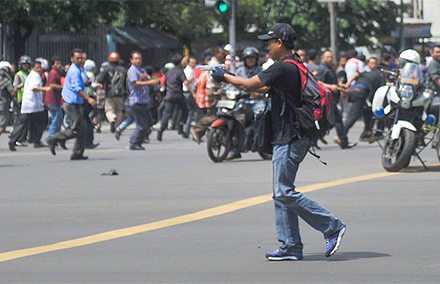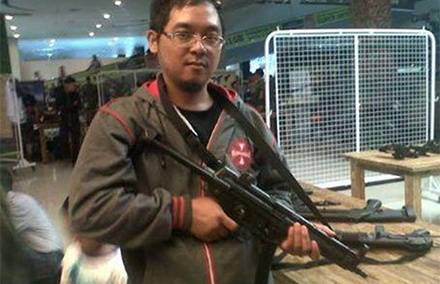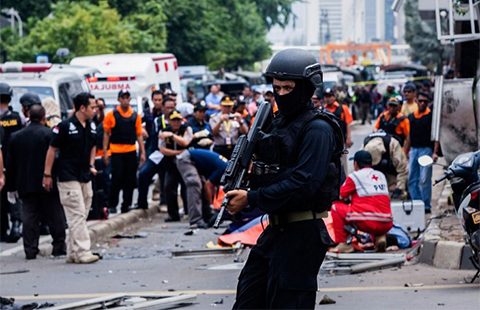
A terrorist fires at police in Jakarta.
The latest terrorist attack in Southeast Asia is an attempt to create new leadership among the region’s militants. And, as Zachary Abuza writes, in the bid for the top role, the attacks may escalate.
The attack in Jakarta that killed eight and wounded 25 should have been no surprise.
Since 2014, the Islamic State of Iraq and the Levant (ISIL or ISIS to others) has increased their base of support across Southeast Asia and revitalised terrorist networks that had been in disarray.
Many point to the similarities between this attack and the recent attacks in Paris; barricade-style assaults, in which a few gunmen swarm into an area, kill as many civilians as possible before confronting responding security forces.
The attraction of this type of attack is clear: it requires low technical sophistication, often without any IEDs whatsoever, a limited amount of small arms training and a lot of testosterone. It requires little skill or even training. The barriers to entry are low, the opportunity to inflict a large number of casualties at the place of choosing is high, and the ability to garner media attention to your cause is, likewise, very high.
Jakarta was a case in point, a handful of men, with little training and very old weapons, were able to cause mass casualties and engage security forces in a two-hour standoff. The quick response of the security forces prevented what could have been a much larger tragedy.
But one should recall, this was not a mere emulation of Paris. The large Jemaah Islamiyah (JI) cell that was broken up in 2010 had a camp in Aceh to train for the same style of attack, first embraced by the Lashkar e-Taiba in Mumbai in November 2008. Indeed, one of the four militants killed in the Jakarta attack, Sunakim, had previously been arrested for training in that camp.
This style of attack will become a ready tool in the toolbox in Southeast Asia. Most Southeast Asian militants who fight with ISIS are front-line troops, with nothing more than small arms training. And for those who are unable to travel to Iraq and Syria due to proactive policing, these attacks can still be adopted, with some degree of success.
But it will not be the only tactic. There have been four IED plots disrupted in Malaysia, including an attempted suicide bombing late last week. In March 2015, a returnee from Syria tried to detonate a chlorine bomb in a Jakarta shopping mall. There is a danger in preparing for only the last type of attack.
There has and will continue to be much ink spilled on what the attack in Jakarta means. Was it an IS attack, or merely an IS-inspired attack? For me, the attack is significant for one reason, and one reason only; it is as an attempt to create a new leadership for Southeast Asian militancy.
JI was systematically taken apart following the 9/11 attacks on the United States and the October 2002 Bali bombing. JI perpetrated attacks in 2002, 2003, 2004, 2005, 2007 and 2009. But each attack ended up weakening the group and each arrest garnered more intelligence. There were well over a 1,000 arrests across Southeast Asia.
More importantly, those arrests led to intense factional debates within the organisation. Malaysian bomb-maker Dr Azahari bin Hussin was frustrated with the slow pace of attacks, roughly one a year, and wanted to increase the tempo, with more, though smaller suicide attacks, as happened in Bali in 2005. His protégé, Noordin Mohammad Top, doubled down on the al-Qaeda line of targeting the “far enemy” until his death in 2009. Abu Dujana and others weren’t morally opposed to those attacks, but saw them as counterproductive in the current context, and pushed for a resumption of sectarian conflicts in Sulawesi and the Malukus. Neither side was able to garner enough support or effectively execute their strategy and both were taken apart by Indonesian security forces.
Dulmatin and Umar Patek tried to bridge the divide in 2010, with the Aceh cell that wanted to launch frequent, low cost, low tech barricade style attacks. But security forces broke up their cell, arresting or killing over 125 people in early to mid-2010, including the leadership, and their financier Abu Bakar Ba’asyir, once JI’s amir, or spiritual leader. From that point on, JI ceased to being an organisation with any centralised leadership.
This development mirrored debates within al-Qaeda, between Osama bin Laden, who wanted a centralised organisation, and Musab al-Suri, who saw that as being a strategic weakness. He argued that al-Qaeda should be nothing more than an ideology to inspire self-radicalised groups. And while he was correct in arguing that a formal organisation was a strategic weakness, the reality was that small cells and lone wolves were never more than the sum of all parts.
And that was particularly true in Southeast Asia.
By 2010, the pieces of the JI organisation and affiliated groups and charities remained divided over strategy and tactics, ego, limited resources and the impossibility of reconstituting itself under intense dragnets by security forces that had accumulated vast intelligence and knowledge, and were working with one another more effectively.
There were many successor organisations or splinters, but they varied greatly in terms of their capabilities, size and ability to engage in sustained violence. Some, such as the Eastern Indonesian Mujahideen (MIT), under the leadership of Sentoso, remain consistently lethal though geographically contained.
More importantly, each group has tried and failed to assume the leadership mantle and unify disparate organisations. And that’s where ISIL comes into play.
Although more Southeast Asians joined al-Nusra at first, recruitment into ISIL has grown, owing to the latter’s control of resources and territory, as well as its slick propaganda and, until recently, battlefield successes.
ISIL reinvigorated and revitalised dormant terrorist networks, charities and social organisations. It allowed militants to travel overseas, gain combat experience and, more importantly, organise.
Many groups across the region have pledged bai’at (allegiance) to ISIL, including the Abu Sayyaf, Anshaur al Khalifah and the Bangsamoro Islamic Freedom Fighters in the Philippines, and the Jemaah Ansharut Tauhid (JAT) and MIT in Indonesia.
Some did so for opportunistic reasons, others to garner media attention or in the hopes of gaining financial support from ISIL. In the case of the Abu Sayyaf, the spectre of beheadings of captives was seen as a way of raising the psychological pressure to command higher ransoms.
And yet, these groups remain largely autonomous and divided. However, the growth in stature of the Bahasa-speaking company of ISIL, Katibah Nusantara, is changing that. Indonesians Bahrun Naim and Malaysian Muhammad Wanndy Mohamad Jedi, founding members of Katibah Nusantara, are using the group as the nucleus of a new leadership.
While their battlefield success against Kurdish Peshmerga or the recent suicide attacks that killed more than 30, including 12 Iraqi police, both by Malaysians, are important, they need to act at home to begin to consolidate power. That’s why the attack in Jakarta is so important.

Bahrun Naim; the ‘mastermind’ behind the recent Jakarta terror attack.
In the terrorism literature, there is a concept of “outbidding”. While we may be aghast at attacks against innocent civilians, or the beheadings of captives, they resonate deeply in the jihadist milieu. They are a source of empowerment.
More significantly they are a way to prove your leadership through actions. And for someone to garner the attention of both Southeast Asia’s militants as well as ISIL leadership, one must command a sustained campaign of violence. Nothing else, including fiery oration by known ISIL clerics such as the incarcerated Abdurrahman Aman, matters.
The Jakarta bombing was not just an attack against civilians or meant to discredit the Indonesian government or an act of revenge for the concerted campaign against MIT. Nor was it merely revenge for the arrest of some 11 suspects who were planning a wave of sectarian attacks against the small Christian and Shia communities in December. This attack was a move to make Katibah Nusantara the new leadership within Southeast Asian jihadist circles.
But the logic of “outbidding” is that because of the zero sum competition between ISIL cells and al-Qaeda, as well as an alphabet soup of other groups, there must be more violence to stay relevant. This is an ideological battle to be the vanguard organisation in Southeast Asia. But deeds speak far louder than words.
Zachary Abuza is a professor at the National War College where he focuses on Southeast Asian politics and security issues. Read his report, “Joining the New Caravan: ISIS and the Regeneration of Terrorism in Southeast Asia”, here.
 Facebook
Facebook  Twitter
Twitter  Soundcloud
Soundcloud  Youtube
Youtube  Rss
Rss 